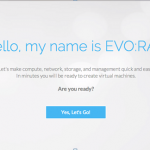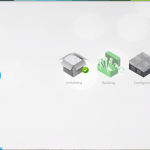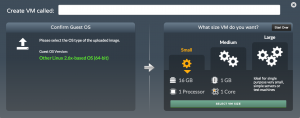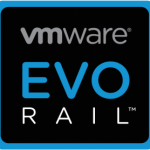This post is also available in: Italian
Reading Time: 6 minutesAs written in the previous post, there are different approaches for implement a SDDC and EVO:RAIL represent the VMware’s way for implement fast and in a simple way an Hyper-Converged Infrastructure.
EVO represents an entire new family of Hyper-Converged Infrastructure offerings from VMware, and EVO:RAIL represents the first product in this family. It was announced in this VMworld 2014 (with a first list of EVO partners) and will be available during the second half of 2014.
Note that this product will be available only through qualified EVO partners (similar in the concept on how vSphere could be sold through a pre-installed OEM channel). But in this case will be ONLY thought this way: if you want to play with EVO:RAIL you must buy an entire solution or use the Hands on lab. Announced partners include Dell, EMC, Fujitsu, Inspur, NetOne and SuperMicro.
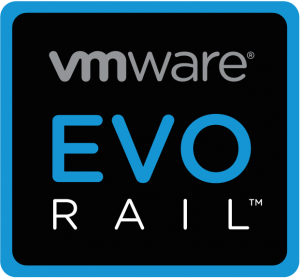 From the tecnical point of view the EVO:RAIL “building block” is a 2U system composed by 4-Node unit (just microserver), where each node is an independent physical server within the 2U enclosure (this make microserver different, for example, from blades).
From the tecnical point of view the EVO:RAIL “building block” is a 2U system composed by 4-Node unit (just microserver), where each node is an independent physical server within the 2U enclosure (this make microserver different, for example, from blades).
The form factor (initially will be only this) has been choosed for simplify the decision (no choice, just add more node) but also the deployment and the efficiency.
Each of the four nodes in a EVO:RAIL appliance have (at a minimum):
- Two Intel E5-2620 v2 six-core CPUs
- 192GB of memory
- Internal Drive Bays for the entire appliance – up to 24 hot plug 2.5 drives
- One SLC SATADOM or SAS HDD as the ESXi™ boot device
- Three SAS 10K RPM 1.2TB HDD for the VMware Virtual SAN™ datastore
- One 400GB MLC enterprise-grade SSD for read/write cache
- One Virtual SAN-certified pass-through disk controller
- Two 10GbE NIC ports (configured for either 10GBase-T or SFP+ connections)
- One 1GbE IPMI port for remote (out-of-band) management
- 1 x Expansion Slots PCI-E
- Dual PSU – rated between 1600W
Each EVO partner could make something different, but those will be the minimum requirements, and the form factor actually is fixed (but I suppose that there will be other form factor, for example for VDI environments where GPU are needed).
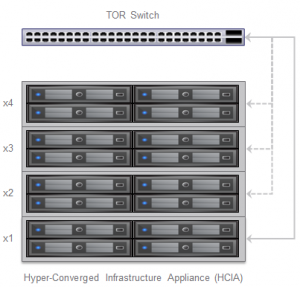 Will be possible scale out up to four Hyper-Converged Infrastructure Appliance (HCIA), for a maximum of 16 nodes in a cluster (considering the vSphere limit, will be possible to have more in next release).
Will be possible scale out up to four Hyper-Converged Infrastructure Appliance (HCIA), for a maximum of 16 nodes in a cluster (considering the vSphere limit, will be possible to have more in next release).
The top of rack (ToR) switch is not included in the EVO:RAIL requirements, but of course will be needed (an possible with good redundancy), so probably some EVO partners will build a complete offer.
Note that storage will be provided by Virtual SAN, as could be expected in an Hyper-Converged Infrastructure.
But the most intesting aspect of EVO:RAIL is how easy is deploy, configure and also manage it:
- Rapid configuration in minutes
- Simple management with a pure HTML5 interface
- Easy non-disruptive upgrades
- Automatically scales out
The installation is almost simple (and fast) and based on a guided and autmatical deployment mode both for ESXi (note that is something new, not the AutoDeploy system) and for the virtual appliances (like vCenter Server).
And the management will also be simple, though the new HTML5 interface (compatible with any browser without any plugin and with any device!), but note that is just a “wrapper” to the vSphere API, so you can choose to use the new interface or still the vSphere Web Client to manage your environment.
The new interface will be more simple and faster for common tasks and could become also something more (for example a self-provisioning and/or multi-tenant UI).
For sure this could awesome for customers that need to build new infrastructure and potentially (as seen in several post) could be valuable for the SMB and the Mid-size. The only limit that I see is potentially the cost: the vSphere edition will be the Enterprise Plus one, where the cost is not so much SMB friendly! But actually we have to wait to see first proposal of EVO:RAIL appliances.
It’s all perfect? Probably no, but seems really promising. It’s just version 1.0, but the UI is fast and reactive (seems that there is a lot of experience derivated from vCloud Hybrid Service), but some features is missing in this version: for example the hardware managment could be better (hardware lifecycle is separated, and other tools are needed, like for firmware upgrade), EVO:RAIL lacks of API and probably also for plug-in… but lot of new features are already planned for the next release.
Will this solution kill other converged or hyper-converged infrastructure? For sure will be something strange: most of the EVO partners have existing solution based on “building blocks” converged or also hyper-converged (for example Dell has the vStart but also the Nutanix alliance) and will be interesting see if those solution will remain (for example for other hypervisor or for OpenStack implementation) or will be dropped.
And will change the role of system admins (or the virtualization admins)? Maybe, but to be honest, also the existing “block-based” solution are reducing the effort for the deployment and installation and existing management/monitoring tools are reducing the operational effort. But good architects are still needed and skill may change, but integrations, automation and organization capabilities will be still needed.
About the name, seems confirmed that EVO stands for ‘Evolutionary’ and RAIL simply represent the ‘rail mount’ attached to 2U/4-node server platform that allows it to slide easily into a datacenter rack. Previously EVO:RAIL was also know by the projects name: Marvin (Marvin Droid is visible in some screenshots) or Mystic.
For more information on EVO:RAIL see also:
- Meet VMware EVO:RAIL™ – A New Building Block for your SDDC
- What’s New at VMware VMwold: EVO:RAIL and EVO:RACK
- VMware EVO:RAIL – Overview
Note that EVO:RAIL is the first product of the EVO family, but no long the only one: EVO:RACK (a hyper-converged infrastructure project) has been announced as a Technology Preview.


